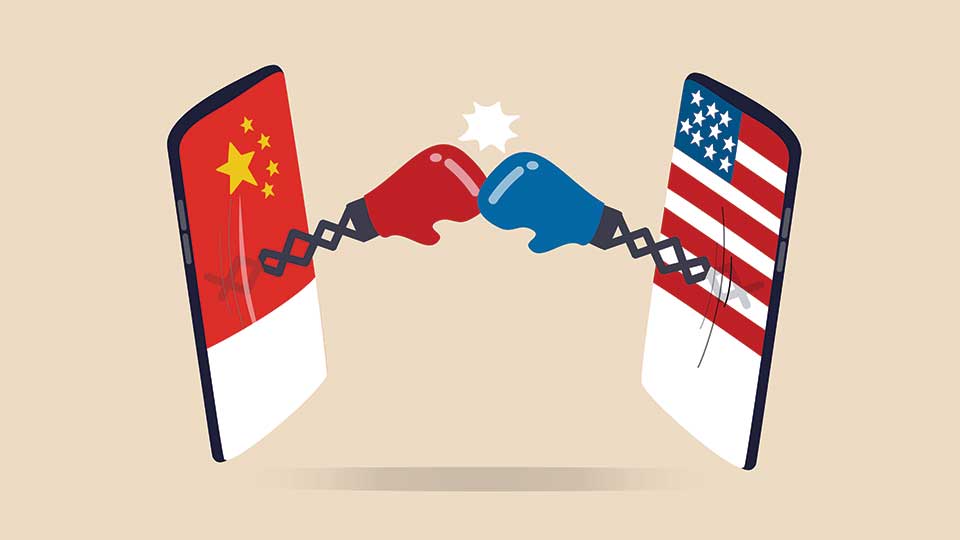The tech sector has become the battleground ground for the two largest economic
competitors, China & the United States of America. The trajectory of this rivalry is based on China’s vast resources, firm willingness for revisionist aims, and rapid influence in the global governance entities. In recent years technological advancements have escalated that have disrupted the geopolitical equilibrium. The US status quo is trying to maintain the balance of power by adopting a confrontational posture. Both the great powers have engaged in the clutches of unprecedented tech rivalry. The geographical redistribution of production and enhanced technology capabilities have led to a progressive transformation in the institutional framework of international trade from the free trade, globalizing paradigm, to the current emergent techno-nationalisms.
The techno-nationalism is a new form of Geopolitical rivalry that transcends traditional
notions of power. In the age of hyper-globalization and multiplorization of the world economy, the concept of techno-nationalism is a dominating phenomenon. This concept is reshaping the contours of International relations and challenging the traditional norms of technological cooperation thus leading to a bifurcated world order. Both states see technological competition as a ‘zero-sum’ game which is evident through competition policy approaches.
The United States, with efforts like the National Security Innovation Base (NSIB), seeks to preserve its technological edge by prohibiting the export of critical technologies and scrutinizing foreign investments. In contrast, China, motivated by its “self-reliance” strategy, strives for technological autonomy and reduces reliance on foreign innovations, indicating a departure from the era of technological globalization. China has ceased to utilize computers and software manufactured in other countries by its public institutions and government organizations. This action seems to be directed at U.S. businesses as the U.S. continues its global push to prevent the use of 5G wireless technology, which is produced by the Chinese telecom behemoth Huawei.
National security concerns had a significant impact on the technological cold war. The US foreign policy abandoned its prior commitment to democratic values and free expression in the technology sector to protect national sovereignty. In May 2019 the trump administration issued an executive order which not only forbade American companies from supplying Huawei, the largest telecom company with components but restricted domestic networks from using its equipment. U.S. claims that Huawei equipment might expose the US to surveillance by the Chinese intelligence services. However, the US sanctions were not just caused by Huawei’s security issue but also by America’s self-insecurity that their economy is outpaced by the Chinese as evidenced through the previously imposed sanctions on Alstom and Toshiba.
The technological rivalry has unleashed a multifaceted paradigm of Cold War 2.0. These technologies are believed to offer a crucial advantage not just to militaries in a potential conflict, but also in unleashing essential economic growth, crucial for success. This conflict spans not only economic and technological aspects but extends broadly into the realms of national security, ideology, and global influence. At the core of this technological cold war is the quest for global technological hegemony which is motivated by a desire to dominate trend-setting technologies.
These technologies such as semiconductors, artificial intelligence, 5G telecommunications, and smart cars, as well as quantum computing, bioscience, and blockchain technology, serve as a battlefield where both nations struggle for supremacy, acknowledging that technological leadership corresponds to strategic advantage in the global arena. For instance, the Biden administration enforced a prohibition in August on U.S. venture capital investment in China’s pivotal technology sectors. While the goal was to target military applications, these restrictions form part of a broader, specific effort to impede China’s pursuit of technological dominance, which began with actions to impose export controls on advanced semiconductors earlier in 2022.
The trade tensions between the U.S. and China, characterized by reciprocal tariffs and export controls, have reverberated across the global economy. The technology industry, a pivotal component of both countries’ economies, has experienced a restructuring of supply chains, prompting companies to reassess their dependencies and explore alternatives to manage risks.
Semi-conductors are the heart of modern technology. The major driver of technology Cold War is the semiconductor which plays a pivotal role in the strategic and economic struggle of the two countries. Both states view control of semi-conductor production as a vital phenomenon to achieve their competing agendas; the U.S. to maintain its technological edge and China to build Self-sufficiency.
Cyber espionage has further heightened the tensions, with both nations targeting each other for malicious activities in cyberspace. The formation of offensive and defensive cyber capabilities has become inevitable to the military strategies of both states, escalating further complexity in technological warfare.
The aggressive foreign policies have also caused unintended consequences for U.S. companies like Qualcomm, Broadcom, Intel, and others, who conduct significant business with Huawei alone, amounting to billions of dollars. Consequently, as the U.S. and its allies engage in competition with China in the industries of the future, encompassing all 10 sectors outlined in the Made in China 2025 plan, they may encounter challenges in avoiding what is known as the “Galapagos Syndrome”-which is a thesis that proposes that safeguarding domestic industries fosters national champions, yet hampers their capacity to adjust and thrive in international markets.
Although the US retains dominance in vital sectors like software and semiconductors, Chinese companies are advancing or have already surged ahead in industries such as smartphones, drones, and electric vehicles. America’s complacency and its short-term emphasis on profit-centric globalization have created a void for China to capitalize on weaknesses and diminish US technological supremacy.
As the United States and China navigate through the current technological conflict, the global technological terrain finds itself at a critical juncture. Countries and businesses are faced with the dilemma of adhering to traditional norms of technological cooperation or aligning with either of the two dominant technological powers.
The escalating technological rivalry between the United States and China, which has transitioned into a “technological cold war,” carries significant ramifications for the trajectory of geopolitics and technological advancement. As this narrative unfolds, global observers are keenly attuned, observing the pivotal role these developments will play in reshaping the landscape of international relations for generations to come.

Table of Contents
ToggleMalaika Shamim Alam
Malaika Shamim Alam is a dedicated scholar pursuing a Bachelor's in International Relations at the International Islamic University Islamabad. With a keen focus on geopolitics, international law, and the dynamics of the new world order, she delves into areas such as international political economy, comparative politics, foreign policy analysis, cybersecurity, hybrid warfare, and arms control, aiming to contribute insightful perspectives to the global discourse.













